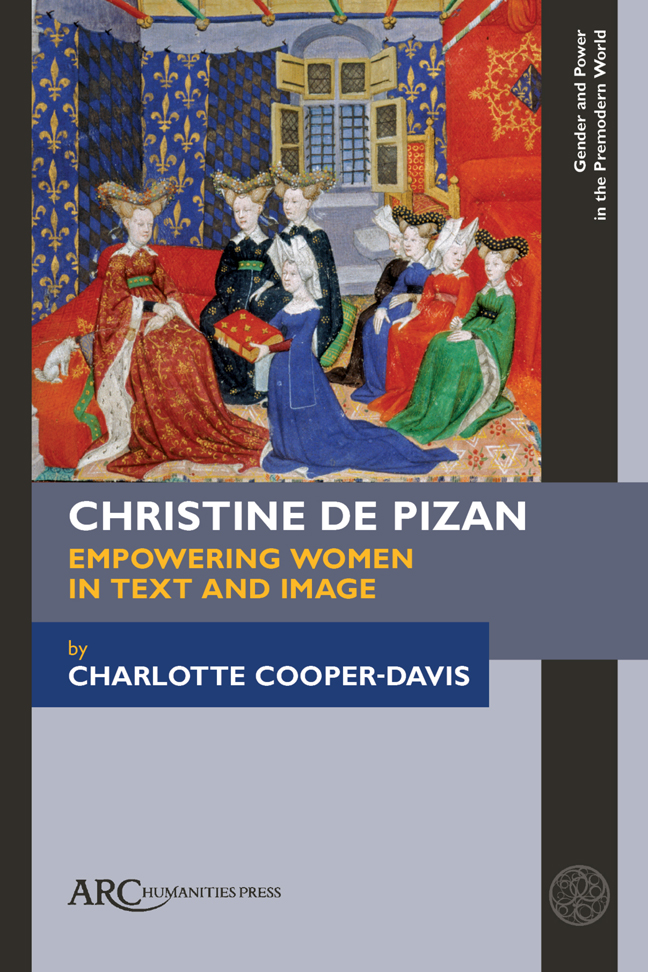Book contents
- Frontmatter
- Dedication
- Contents
- List of Illustrations
- Acknowledgements
- Abbreviations
- Note on Translation
- Introduction
- Chapter 1 Conventions, Collaboration, and Craft: Representing the Author in Christine de Pizan's Author-Manuscripts
- Chapter 2 Wisdom, Chastity, and War: The Power of Female Didactic Figures
- Chapter 3 Female Creation and Education in Le Livre de la mutacion de Fortune
- Chapter 4 Assessing the Gender of Christine's Audiences
- Conclusion
- Christine de Pizan's Illustrated Author-Manuscripts
- Bibliography
- Index
Introduction
Published online by Cambridge University Press: 20 February 2024
- Frontmatter
- Dedication
- Contents
- List of Illustrations
- Acknowledgements
- Abbreviations
- Note on Translation
- Introduction
- Chapter 1 Conventions, Collaboration, and Craft: Representing the Author in Christine de Pizan's Author-Manuscripts
- Chapter 2 Wisdom, Chastity, and War: The Power of Female Didactic Figures
- Chapter 3 Female Creation and Education in Le Livre de la mutacion de Fortune
- Chapter 4 Assessing the Gender of Christine's Audiences
- Conclusion
- Christine de Pizan's Illustrated Author-Manuscripts
- Bibliography
- Index
Summary
Haulte dame, en qui sont tous biens,
Et ma trés souvraine, je viens
Vers vous, comme vo creature,
Pour ce livre cy que je tiens
Vous presenter, ou il n’a riens,
En histoire n’en escripture,
Que n’aye en ma pensée pure
Pris ou stile que je detiens
Du seul sentement que retiens
Des dons de Dieu et de nature.
(Noble lady, in whom all good things are found, my sovereign, I come before you as your creature to present to you this book that I hold. It contains nothing, in word nor in theme, that I have not extracted from my own thoughts and rendered in the style that I hold from the gifts of God and of nature)ON BENDED KNEE, in a richly decorated room adorned with golden fleurs-de-lys on a royal blue background, Christine de Pizan presents her book to Isabeau de Bavière, the Queen of France, whose ladies-in-waiting look on. The scene is visually striking, composed of bold colours (the bright red and blue are particularly vivid) and gold leaf, the whole enclosed within a frame of delicate filigraned decorations. Such is the exquisite dedication miniature of the manuscript now known as “The Queen's Manuscript” or “Book of the Queen,” London, British Library, Harley MS 4431 (see Figure 1 ). The size of the image further underscores its significance: uniquely among the dedication miniatures found in Christine's corpus of surviving author-manuscripts, it makes use of the full two-column width of the page. The content of the image is also remarkable for its realism: not only can the women who are present in the scene be identified with some certainty, but as Sandra Hindman has shown, rather incredibly, “it also reproduces details of dress, tapestry, and furniture that correspond with descriptions in the royal accounts.” The visual presentation has a textual counterpart, of which part is cited in the above epigraph, in which Christine emphasizes her position as donor presenting her book to a noble patron, as well as her role in preparing the manuscript's content. The text mirrors details found in the image, such as Christine coming before Isabeau holding the book in her hands in a traditional author pose. Together, the text and image found at the opening of the Queen's Manuscript form a distinctive and memorable scene.
- Type
- Chapter
- Information
- Christine de Pizan , pp. 1 - 24Publisher: Amsterdam University PressPrint publication year: 2023

